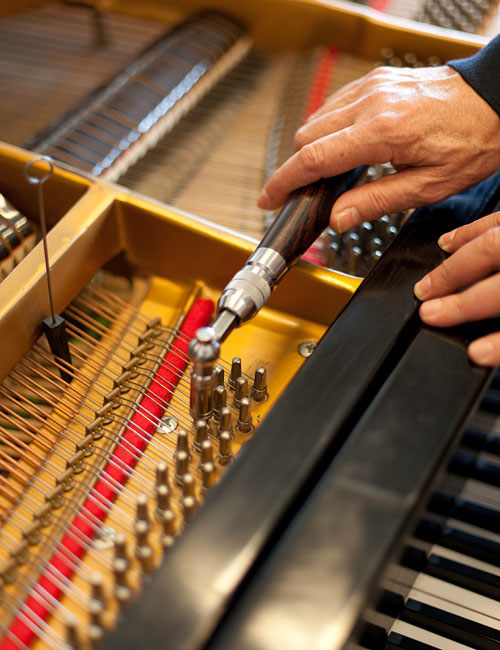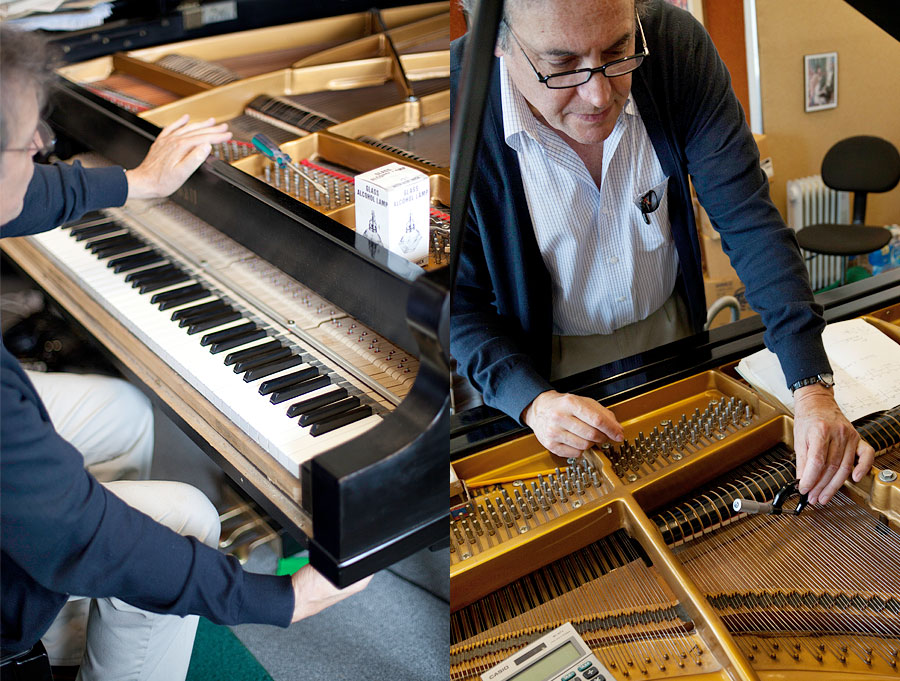The Art Of Tuning
The Importance of Keeping Your Piano Properly Tuned
A piano is at once an amazing piece of technology, perhaps the most rewarding musical instrument and a beautiful piece of furniture.
Unlike a violin, cello or guitar which is tuned each time they are played, we expect a piano to stand in tune for long periods of time. Because each string of a piano is stretched at about 180 lbs. of tension across a flexible soundboard, any change in the soundboard is certain to affect the pitch of each string.
Actually, every change in the weather including the humidity and barometric pressure affects the wooden soundboard and the pitch. Over time, these cause minute rises and drops which alter the piano's ability to stay on pitch.
We not only expect the piano to be in tune with itself (including the many unisons: 3 strings for each note) but we also want the overall pitch to be as close to A440 as possible.
Many professional clients of mine, like Sarah McLachlan hire me to tune their piano twice in one day for a performance so that the piano closely matches the other keyboards and instruments. The more we have to raise or lower the pitch, the more quickly the piano can come out of tune.
Twice a year careful tuning is the Industry Standard and generally produces the best results while new or rebuilt pianos should be tuned more often for the first two years to stretch the steel strings and 'break-in' the piano. Regular tuning can greatly enhance the quality of the finest Rebuilt Steinway or even a child's first spinet piano.
The Art (and Science) of Piano Tuning:
Simply put, piano tuning is adjusting the tension on every string to the correct pitch. However, there's so much more involved: the piano is a fixed intonation instrument like an organ or a xylophone.
The piano is different from instruments like a violin, trombone or a singer, in that it cannot minutely alter its' pitch higher or lower (sharper or flatter) in a performance.
If tuned in perfect intervals, some of its' other intervals (like the octave) would be hopelessly out of tune. This has been known since ancient times as the Pythagorean Comma. Therefore, the piano scale needs alteration or Temperament in order to become musically useful.
Traditionally, some keys (scales) were tuned more beautifully and purely while others (C# major, c# minor or A flat major for instance) were discarded and never used. Around Bach's time a radical idea emerged: since the distances involved in these errors were small and the advantages to being able to use all the scales was great, why not abandon some of "nature's perfect intervals" and use a mathematical system to distribute the errors equally throughout the twelve notes and all the scales?
This was a very radical idea in its age considering many scientists like Galileo had been imprisoned for challenging ideas about the "natural order." Bach did not invent this system but he used it and wrote 48 great Preludes and Fugues in every key to establish the acceptance of Equal Temperament.
Now we have a great pattern for tuning the rest of the notes. The next problem is that the piano was engineered for volume in the 19th Century so it has a cast iron frame or plate that supports thick tight strings (with 20,000 lbs. of tension) that enable the piano to be heard in a large concert hall.
These thick tight strings have overtones that don't behave according to their theoretical frequencies (inharmonicity). Therefore, we must use acoustical tests to verify that our octaves are correct and that we have transferred our tempered scale to every register of the piano. Next we must deal with the piano hammers the 'accidental genius' of the piano. Due to the unusual nature of piano strings, minute changes in the compression or groove of the hammer can actually affect the pitch (help temper the string).
Lastly, all the strings are stretched over bridges which are themselves glued to a soundboard which is the acoustical amplifier of the piano. In order to be a good amplifier, flexible wood like spruce is used for the soundboard. If the humidity is too low, the whole board becomes something like a trampoline, when one string is tightened another note an octave away can suddenly rise or fall!
So, it takes great patience and skill to tune a piano but the rewards of this great instrument surely make it worth it.



